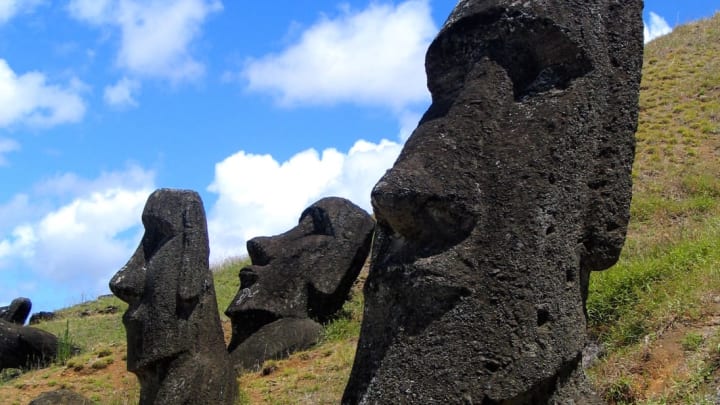The Moai statues of Easter Island present one of the world's greatest technical mysteries. The stone heads (actually full bodies) that dot the island in the South Pacific are massive and number in the hundreds, prompting archaeologists to wonder how they got there in the first place. Now, as Newsweek reports, a group of researchers believe they're closer to finding an answer.
European sailors first arrived on Easter Island in 1722 and were greeted by a native population of 1500 to 3000. Along with the residents were 900-odd statues carved from solid rock, meaning there were fewer than four people for every massive monolith.
How was such a thin population able pull off such an impressive feat of architecture? According to researchers from Chile, New Zealand, and the U.S., it's possible they had help. Their new study published in the journal Frontiers in Ecology and Evolution suggests that the statues were carved and erected at a time when Easter Island supported a much larger population. Using data from the island, they estimated just how high the island's numbers may have reached.
Easter Island has the agriculture potential to sustain a maximum population of 17,500, researchers say. This estimate is based on the weather and soil quality of the island, 19 percent of which is capable of growing the sweet potatoes that fed inhabitants. "Despite its almost complete isolation, the inhabitants of Easter Island created a complicated social structure and these amazing works of art before a dramatic change occurred," lead author Cedric Puleston said in a statement.
If the Moai were constructed by a much larger group than the Europeans encountered, that would clear up some of the mystery surrounding the island. But it would also raise more questions. How, for instance, did the population fall so quickly in the few centuries between the statues' construction and first contact with Europeans? One theory is ecocide, which happens when an area is exhausted of its resources faster than it can replenish them.
The mystery of how the towering monoliths were transported across the island after they were built still remains. The indigenous people told Dutch explorers that the Moai walked themselves, an explanation an MIT professor put to the test when he designed a 2000-pound sculpture that could be shimmied long distances. But despite the numerous theories, hard evidence related to the figures' origins remains scarce.
[h/t Newsweek]
